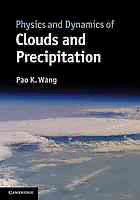
Physics and Dynamics of Clouds and Precipitation PDF
Preview Physics and Dynamics of Clouds and Precipitation
i C:/ITOOLS/WMS/CUP-NEW/3457800/WORKINGFOLDER/WANN/9781107005563HTL.3D [1–2]13.10.20125:15PM PHYSICS AND DYNAMICS OF CLOUDS AND PRECIPITATION What does a cloud contain and how does it form? How and why does lightning occur?HowmightcloudschangetheEarth’sclimate? This key new textbook provides a state-of-the-art view of the physics of cloud and precipitation formation, covering the most important topics in the field: the microphysics,thermodynamics,andcloud-scaledynamics.Highlightsinclude:the condensationprocess explained,with new insights from chemical physicsstudies; theimpactofparticlecurvature(theKelvinequation)andsoluteeffect(theKöhler equation); homogeneous and heterogeneous nucleation from recent molecular dynamics simulations; and the hydrodynamics of falling hydrometeors and their impact on collision growth. Three-dimensional cloud-model simulations demon- strate the dynamics and microphysics of the formation of deep convective clouds and cirrus, and each chapter contains problems that enable students to review and implementtheirnewlearning. Packed with detailed mathematical derivations and cutting-edge stereographic illustrations,thisisanidealtextforgraduateandadvancedundergraduatecourses, andalsoservesasareferenceforacademicresearchersandprofessionalsworkingin atmosphericscience,meteorology,climatology,remotesensing,andenvironmental science. pao k. wang is a Professor in the Department of Atmospheric and Oceanic Sciences, University of Wisconsin-Madison, where he has been teaching and conducting research for more than 30 years. He has won much recognition for hiscontributionstoatmosphericscience,includingtheAlexandervonHumboldt Award,anS.C.JohnsonDistinguishedFellowship,andelectionasaFellowofthe American Meteorological Society and the Meteorological Society of Taiwan. Professor Wang has been the principal investigator of numerous research grants sponsored by NSF, EPA, NASA, and DOE, covering topics in cloud physics, clouddynamics,aerosolphysics,airpollution,andhistoricalclimatology.Heisan associateeditorofAtmosphericResearchandEuropeanJournalofPhysics-Plus, a member of the international advisory board of Terrestrial, Atmospheric and Oceanic Sciences, and is also currently an advisory committee member of the Research Center for Environmental Change (RCEC), Academia Sinica- Taiwan. ii C:/ITOOLS/WMS/CUP-NEW/3457800/WORKINGFOLDER/WANN/9781107005563HTL.3D [1–2]13.10.20125:15PM Praiseforthisbook: “this is a dummy quote this is a dummy quote this is a dummy quote this is a dummyquotethisisadummyquotethisisadummyquotethisisadummyquote thisisadummyquotethisisadummyquotethisisadummyquote” –Reviewer1,somewhere “this is a dummy quote this is a dummy quote this is a dummy quote this is a dummyquotethisisadummyquotethisisadummyquotethisisadummyquote thisisadummyquotethisisadummyquotethisisadummyquote” –Reviewer2,somewhere iii C:/ITOOLS/WMS/CUP-NEW/3457800/WORKINGFOLDER/WANN/9781107005563TTL.3D [3–3]13.10.20125:17PM PHYSICS AND DYNAMICS OF CLOUDS AND PRECIPITATION PAO K. WANG UniversityofWisconsin-Madison iv C:/ITOOLS/WMS/CUP-NEW/3457800/WORKINGFOLDER/WANN/9781107005563IMP.3D [4–4]13.10.20125:18PM cambridge university press Cambridge,NewYork,Melbourne,Madrid,CapeTown, Singapore,SãoPaulo,Delhi,MexicoCity CambridgeUniversityPress TheEdinburghBuilding,CambridgeCB28RU,UK PublishedintheUnitedStatesofAmericabyCambridgeUniversityPress,NewYork www.cambridge.org Informationonthistitle:www.cambridge.org/9781107005563 ©PaoK.Wang2013 Thispublicationisincopyright.Subjecttostatutoryexception andtotheprovisionsofrelevantcollectivelicensingagreements, noreproductionofanypartmaytakeplacewithoutthewritten permissionofCambridgeUniversityPress. Firstpublished2013 PrintedintheUnitedKingdomattheUniversityPress,Cambridge AcataloguerecordforthispublicationisavailablefromtheBritishLibrary LibraryofCongressCataloguinginPublicationdata Wang,PaoK. Physicsanddynamicsofcloudsandprecipitation/PaoK.Wang,UniversityofWisconsin,Madison. pages cm Includesbibliographicalreferencesandindex. ISBN978-1-107-00556-3 1. Cloudphysics. 2. Precipitation(Meteorology) I. Title. QC921.5.W363 2013 551.5706–dc23 2012027751 ISBN978-1-107-00556-3Hardback CambridgeUniversityPresshasnoresponsibilityforthepersistenceor accuracyofURLsforexternalorthird-partyinternetwebsitesreferredto inthispublication,anddoesnotguaranteethatanycontentonsuch websitesis,orwillremain,accurateorappropriate. v C:/ITOOLS/WMS/CUP-NEW/3456460/WORKINGFOLDER/WANN/9781107005563DED.3D [5–6]13.10.201212:45PM Tomyparents and toLibby,LawrenceandVictor vi C:/ITOOLS/WMS/CUP-NEW/3456460/WORKINGFOLDER/WANN/9781107005563DED.3D [5–6]13.10.201212:45PM vii C:/ITOOLS/WMS/CUP-NEW/3456460/WORKINGFOLDER/WANN/9781107005563TOC.3D [7–8]13.10.20121:19PM Contents Preface pageix 1. Observationofclouds 1 2. Theshapeandsizeofcloudandprecipitationparticles 27 3. Molecularstructuresofwatersubstance 68 4. Bulkthermodynamicequilibriumamongwatervapor, liquidwater,andice 86 5. Surfacethermodynamicsofwatersubstance 107 6. Aerosolintheatmosphere 134 7. Nucleation 156 8. Hydrodynamicsofcloudandprecipitationparticles 182 9. Diffusiongrowthandevaporationofcloudandprecipitation particles 228 10. Collision,coalescence,breakup,andmelting 252 11. Clouddroppopulationdynamicsinthewarmrainprocess 288 12. Fundamentalclouddynamics 305 13. Numericalcloudmodels 327 14. Cloudelectricity 363 15. Clouds–environmentinteraction 396 References 429 Index 445 vii viii C:/ITOOLS/WMS/CUP-NEW/3456460/WORKINGFOLDER/WANN/9781107005563TOC.3D [7–8]13.10.20121:19PM ix C:/ITOOLS/WMS/CUP-NEW/3456460/WORKINGFOLDER/WANN/9781107005563PRF.3D [9–16]13.10.20121:28PM Preface Cloudsareamagicinthesky.Inaperfectlyclearday,cloudsmaysuddenlyappearfrom nowhere, literally out of the blue, and soon cover the whole sky with inconceivable rapidity. And they can be gone just as quick, if you have ever encountered a sudden rainstorm,sometimesevenwithlightningandthunder,whilehikinginmountain.When youarescurryingtofindahidingplace,therainsuddenlystops,cloudsdisappear,and thesunshinesbrightlyoverthefreshlywashedcypresstrees.Suchwasmyexperience whenIwasajuvenileinTaiwan,asubtropicalcountrywheremountains,sunshine,and water vapor are all abundant. The stir-fry of these ingredients is surely an excellent recipeforcloudmaking. EversinceIwasachild,Ihavebeenintriguedbycloudsandhadwonderedwhere cloudslivedandhowtheycanappearmysteriouslyintheskyandclimbupmountain slopes,andhowsuchseeminglysolidblockscanstayafloatinair.Nobodyseemedto know the answers. Some adults citedan old sayingfromancient Chinese literature: “clouds come out from mountains,” but I had never been able to find any “central storagehouse”ofcloudsinanymountaininTaiwan. SoonedayIwashikinginamountainandsawapatchofcloudrestingontheslope nottoofaraheadupinthewindingpath,andIdecidedtofindoutwhattherewasinthe cloud.IrushedtoitasIwasafraiditwoulddisappear.ButthecloserIwas,themoreit didn’tlooklikeacloud,butratherlikeafog.AndfinallyIwasverysureIwasinit,but I couldn’t see anything tangible. It was even more dilute than many fogs I had experiencedbefore. Later,Ireadapoem ReplytotheImperialInquirybythenoted Taoist hermit scholar and alchemist Tao Hongjing (AD 456–536) who wrote it to declinetheemperor’sinvitationtoserveinthecourt: Whatisthereinthemountain? Overtherangestherearecopiouswhiteclouds ButIcanonlyenjoythembymyself Andamunabletoofferthemasagifttoyou. ix x C:/ITOOLS/WMS/CUP-NEW/3456460/WORKINGFOLDER/WANN/9781107005563PRF.3D [9–16]13.10.20121:28PM x Preface Truly,youcannotevenholdapieceofcloudinyourhand. Butwhatintriguedmemostarethosetallcumulusclouds(toweringcumulus).Inthe summer time of Taiwan, the tropopause is very high and these clouds can easily go above 10 or 12 kilometers. Viewed from a distance, they look like silvery mountain peaks topped with intricate palaces or castles. Old fables maintain that there are immortals living in these palaces. The fable thing fades quickly with age, of course, but one question remained in my mind: How would these tall clouds look if viewed fromthetop? IncollegeImajoredinmeteorologybuttherewasnocloudphysicscourseinthe first 3 years, so I had to satisfy my curiosity by reading Horace Byers’ (1965) Elements of Cloud Physics, the only textbook dedicated to cloud physics in the librarythere.Onlyinmysenioryearwasthefirst-evercloudphysicscourseoffered. Itwasaone-semestercoursebutwastaughtataratherelementarylevel.Meanwhile, another cloud physics book, The Physics of Rainclouds by N. H. Fletcher (1966), becameavailableinthelibrary. In 1973 I went to UCLA to pursue my graduate study and was fortunate to be taken into Hans Pruppacher’s group. Ken Beard, who later became a Professor in UniversityofIllinois,wasaresearchassociatewithHansatthetime.ItwasKenthat gotmeinvolvedinsomeexperimentalworkwithaerosolparticlesthatmarkedthe beginningofmycareerincloudphysics.Hanstaughthiscloudphysicsclassusing hishand-writtennotesandIwaslookingforatextbookforadditionalinformation. I found a used copy of B. J. Mason’s (1971) Cloud Physics for sale in the UCLA studentbookstoreandpurchasedit.BoththisandFletcher’sbooksweremymajor referencesforcloudphysicsinadditiontothelecturenotes. ThereisaninterestinganecdoteofthiscopyofMason’sbook.Inthesummerof 2010IwenttoNCARinBoulder,ColoradotocollaboratewithBobSharman,alsoa UCLAgraduate,onsomeresearchofturbulencegeneratedbydeepconvection.One day Bob lamented that he shouldn’t have sold his copy of Mason’s book after he finished the cloud physics course. He now felt that he needed to consult the book fromtimetotime.ItturnedoutthatthecopyhesoldispreciselythecopyIbought. Of course, I didn’t really know Bob at the time. So, some 37 years later I finally discoveredtheoriginofthatbook. In 1978, Hans and Jim Klett together published their classic Microphysics of CloudsandPrecipitation(PruppacherandKlett,1978),whichwasthemostcompre- hensive cloud physics textbook available at the time. Their second revised and enlarged edition came out in 1996 and has remained the standard reference in this field.WhenIbecameafacultymemberintheUniversityofWisconsin-Madisonin 1980, I began teaching cloud physics using Pruppacher and Klett’s book as the textbook.
